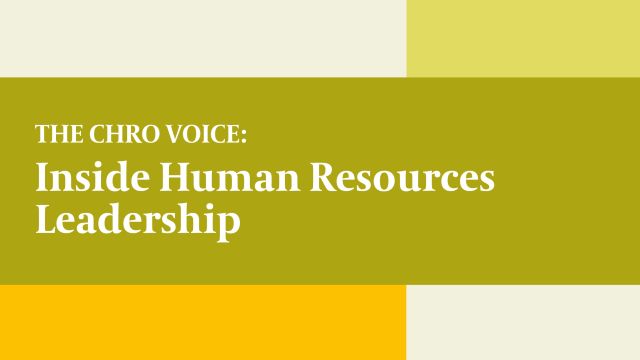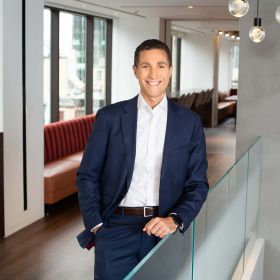The role of the CHRO is central to leadership succession planning, especially for the CEO, which is arguably the most important focus for the board.
 Abigail CharpentierCHRO of Aramark
Abigail CharpentierCHRO of Aramark
Culture is the heart of every enterprise, and at Aramark, Chief Human Resources Officer Abigail Charpentier focuses her energy on sustaining the company’s people-first culture. That can take the form of creating new development offerings or encouraging the leadership team to put themselves in the shoes of employees in the field when developing programs or sending communications.
In this interview, Abigail shares how Aramark is leveraging AI in HR strategy, methods for keeping a global workforce connected and engaged and how she collaborates with the board and C-suite to maintain their hospitality culture.
In your role, how are you engaging with the board and the C-Suite beyond traditional HR responsibilities?
I find the term "traditional HR responsibilities" limiting because our focus is on people who provide service, not physical assets. So, for me, the line between traditional HR duties blurred long ago since our people are central to everything we do. We are heavily involved in all areas of the business, believing that a growth mindset across the company drives real differentiation. Ensuring our hospitality culture permeates the organization is essential for growth, which revolves around having the right people, developing them, and preparing them to lead.
When it comes to engaging with the board, there are some traditional aspects—I have responsibilities with the HR, compensation, and nom/gov committees, but the bulk of the board meeting is a general business meeting. I bring and interweave the HR perspective with what the rest of management is discussing.
Have you noticed any changes in the board's focus on metrics or data related to people over the past few years?
I count myself very lucky to work with a board that is heavily occupied by former CEOs, who come with a broad general management perspective. Since our board reset that started in 2019 and carried through the pandemic, there has been a strong focus on driving growth and cultivating the culture of the organization. Particularly with our CEO returning in 2019, there was a clear change in the organizational culture, and the board has consistently recognized this as a critical part of our path forward.
Our board is always eager for more information about how we are embedding the hospitality culture throughout the organization. They have shown significant interest in engagement survey data, which we initiated in 2021. We've seen increased participation in this survey, which is especially valuable given our distributed workforce and rebuilding required after COVID.
Additionally, the board has been deeply interested in our leadership development initiatives, which we had to recreate from scratch over the past two years. They are interested in metrics that show the growth of the team and ROI on development investments. We share information on percentage of roles with identified successors and internal promotions.
How has the role of the CHRO evolved in C-level succession planning? Can you elaborate on your involvement in these leadership transitions?
The role of the CHRO is central to leadership succession planning, especially for the CEO, which is arguably the most important focus for the board. I've been the CHRO for a little over two years now, and during this time, I've been involved in several key leadership transitions. These include my own transition into the CHRO role, the transition of our head of supply chain and the CFO transition last year. Bringing in the next generation of our leadership team has been a central part of my work with the board where succession planning is an ongoing priority. We have annual in-depth review to keep the pipeline current, maintain focus on development and ensure that we are prepared for future leadership changes. It's crucial not to rest on our laurels and continuously plan for possibilities ahead of us.
Can you tell us about your approach to creating human-centric employee experiences and your talent management priorities?
We set some of that tone at our Headquarters where we've been offering lunches, and collecting feedback on the meal, as part of an example of the services that we provide worldwide. What better place to do that than our test kitchen? This vibrant gathering place promotes in-person interaction, whether people office there, schedule an extra day for meetings or set a lunch appointment to build relationships. For example, an RVP recently scheduled lunch to catch up with me while in town, creating valuable connection points.
But I am also always mindful that we have 260,000 employees globally, and only about 1,000 work at headquarters. So, my focus remains on supporting our field managers and helping them succeed in their jobs. Thinking about how they work every day and putting them in the center of anything that we develop is critical. An example of that is our food service directors. They wear many hats and have to juggle a range of priorities every day—from managing food costs to marketing reports to client meetings. I am always challenging our team to think about how to ease the burden of these responsibilities. Some of the things we’ve implemented based feedback from the field are simple changes like embedding links or QR codes directly into emails, instead of requiring an extra step to access tools for frontline associates. These may sound small but many of our people aren’t in front a computer all day long so making access to resources easier is really helpful.
What strategies are in place to help ensure the pipeline of top talent remains engaged, especially as workforce expectations continue to change for your thousands of frontline workers? How do you approach development?
One of our CEO’s expectations is to reinvigorate leadership development in a meaningful way. We've heard from our people that online learning and coaching are useful but are not substitutes for in-person learning and collaboration. That learning is crucial for facilitating career scaffolding across the organization that drives both development and retention. So, in the last year, we relaunched our in-person Leadership Development series. In February, we held our Talent Accelerator Program, bringing together 16 high-potential pre-RVP leaders. We discussed the organization's vision and strategy. We delved into their personal development, helping them learn about each other and how they can contribute to the organization's strategy and success. This cohort will work together for the next eight months with some virtual touchpoints and other development experiences, culminating in a week at headquarters in November when they will report out to senior leadership on their capstone projects. Integrating this back into our culture is a key part of our strategy.
How are you leveraging AI in your HR strategy, and what’s next for you in that space?
One of the things I've been challenging both my team and our leadership with is to ensure we understand AI and are continuously learning about it because I believe there's a fear factor associated with it. When we first encountered AI at Aramark, we approached it from a compliance perspective because we didn’t want people getting in trouble or getting us in trouble. We were early to establish solid AI governance and communicating safe data practices and basic do's and don'ts. All activities that are an important foundation.
However, this also heightened some of the fear. Some thought, "I don't know if I want to try this because what if I inadvertently do something wrong." To address this, we've been exposing our leadership to AI more, helping them learn and explore its possibilities.
One effective use of AI for us has been a chatbot that supports our recruiting modules. It has revolutionized scheduling with candidates, reducing the average back-and-forth email exchange from three days to under a minute. We've seen great effectiveness here and have implemented significant automation with three full-time bots: Barry, Boris, and Betty. These bots have been incredibly productive, especially in our HR service center, handling repetitive transactional work in recruiting, onboarding, and specific tasks in the hiring process. In many of our environments, there are only a few managers and no HR experts, and our shared services center has limited hours. AI technology can provide on-demand, consistent answers when trained correctly. We have a tool, Sage, which works through Teams. Initially deployed for IT support, we've started training Sage to handle HR requests as well.
My concern, and what I've been emphasizing to the leadership team, is that if we don't continue to engage with AI, it will pass us by. The barriers to entry will become exponential, and we'll be struggling to catch up.
Considering the different generations in your workforce, which includes frontline workers, teammates, and headquarters staff, how do you manage their varying expectations and contributions? Additionally, what impact do you think this mix has on workplace culture globally?
This topic is almost evergreen. When I started working, there was a lot of talk about the new generation and its traits. Now, 30 years later, it's the same conversation I heard in the mid-90s. I believe we're in a people-focused environment where great leaders meet their team members where they are, helping everyone work together and lifting the whole team. I view it more through that lens than focusing on generational specifics. Sometimes, generational differences might appear in certain situations, but isn't that like any group of people working together with different perspectives?
However, we do need to adapt to what appeals to today's workforce compared to five years ago, especially in how we recruit on campuses. We’ve just rebranded an employee resources group, Aramark Young Professionals, to be more inclusive and welcoming to employees from all generations. Now it is Ascend and is positioned to support all leaders, regardless of age or career stage, who are interested in exploring career growth. Our ERGs have always been open to everyone, but we found the original name was off-putting and people weren’t sure if they aged out and were no longer welcome. Reworking the nomenclature helps us to foster more intergenerational conversations and development.
How has your focus on global interconnectedness and collaboration within your organization impacted your approach to leadership and team management?
One exciting aspect for us is recognizing that we're a global hospitality organization. The spin-off of our uniform services business into a standalone company has sharpened our focus on this. It has also made me more aware of how interconnected and transferable approaches are, while still allowing people the freedom to localize, whether in different countries, states or businesses. There's more power when we come together and collaborate. Part of unlocking potential for our organization, our people, and our business results is helping everyone get more comfortable with collaboration and being able to leverage and tap into our shared talents and resources.







